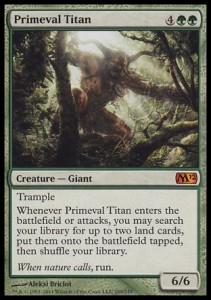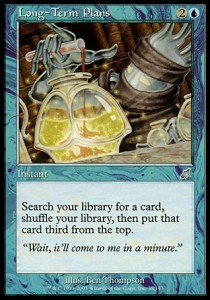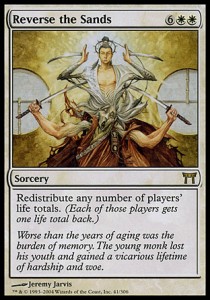One of the most common mistakes I see new EDH players make is taking cards that are good in other formats, say Standard, Legacy, or even Vintage, and assuming that they’re going to be good at the big tables. In some cases that’s true: [card]Sol Ring[/card] is broken no matter how you look at it and [card]Swords to Plowshares[/card] is the best removal spell ever printed in any format, period. But then I see people starting off the game by casting [card]Thoughtseize[/card] on me or trying to pull of [card]Vengevine[/card]/[card]Fauna Shaman[/card] combos and I just have to shake my head and sigh. Hitting someone with a discard spell T1 may set them back a bit, but it also costs you a card, leaving the rest of the table with a full grip of action. 4-power beaters like the aforementioned elemental, well, they’re just not that scary when you have 40 life and a table full of people with decks full of board sweepers. In order to build your deck properly for EDH, you need to do three things: Think Big, Think Long-Term, and Think Multiplayer.

Think Big
The average creature size in EDH used to be somewhere between 4/4 and 5/5, but with the advent of M11’s titans, 6/6 is the new standard for making an impact on the board. Every creature you cast should be subjected to the Titan Test: “Can it tangle with a Titan?” If not, then there sure as hell ought to be another good reason to run it. That said, the rules are somewhat different for fliers. Flying creatures can flit right over the heads of [card]Primeval Titan[/card]s and [card]Sun Titan[/card]s to snipe planeswalkers or apply pressure to an opponent, so they really only have to meet the Dragon Test: “Can it tangle with a 5/5 dragon?” Yes, I know all dragons aren’t necessarily 5/5, but [card]Steel Hellkite[/card] sure is, and that’s the one you’re probably going to see the most often. If a flier doesn’t measure up to the infamous metal dragon, again, you really need to have a good reason to run it.
The inflated standards for creature size have a trickle down effect on the kinds of spells you want to run, too. The most obvious casualty is red removal spells like Lightning Bolt. Yes, they’re format-warpingly powerful in Standard, but in a world of fatties you’re going to have to hunt for a target. Single shot pump spells are similarly weak, and if lifegain is going to make much difference, you’re either going to want to attach it to a creature with lifelink or gain life in truly gigantic double digit increments.
This isn’t to say that you shouldn’t run any small creatures or spells with a CMC less than 6 – far from it. You absolutely want to be able to cast spells on your first 5 turns, after all. It’s just that those spells and creatures need to ramp you, draw you cards, and help control the board, not smash face. Leave the beatdown to the specialists.

Think Long-Term
It’s no secret that EDH games tend to run long, so when you’re putting your deck together make sure to include ways to both utilize as much of your mana as possible every turn and keep your hand stocked up with gas. It’s a fine thing to stock your deck full of powerful cards, but unless you have ways to keep the action coming you’re going to eventually run out of cards and have nothing to do. And believe me, nothing sucks more in EDH than sitting there living off the top of your deck while your opponents are making crazier and crazier plays.
While the typical route towards keeping your momentum in the long game is packing your deck with card draw, another important and equally viable path is synergy. Blink decks and sacrifice decks tend to be the poster children for this concept – playing a [card]Mulldrifter[/card] with [card]Cloudstone Curio[/card] out bounces a [card]Duplicant[/card] and draws you two cards which lets you play the [card]Duplicant[/card] to exile an opponent’s creature and bounce another one of your creatures…it just builds on itself.
Also, it’s worth noting that long games make some cards that would otherwise be fine much less attractive. Take [card]Dark Confidant[/card], for instance. One of the best creatures ever printed, sure, but in a format that goes long and is packed with 6+ CMC spells, it isn’t unheard of for Bob to kill his own controller in fairly short order.

Think Multiplayer
Probably the biggest mental hurdle that most immigrants from competitive play have to get over is the vast impact that a multiplayer environment has on the viability of certain cards. The most obvious examples are cards that get better with more players like [card]Exsanguinate[/card] and [card]Syphon Mind[/card]. While they’re kind of marginal in 1v1, they become absolutely stellar once you start upping the number of players.
There are also cards that become much less effective when there are more players at a table. While you’d be hard pressed to find many cards that are explicitly bad in multiplayer, a whole table full of players changes the usual mathematics of card advantage such that traditional 1-for-1 spells like [card]Doom Blade[/card] and [card]Counterspell[/card] become extremely mediocre. While you’re using a card to take out one of your opponent’s, everyone else at the table actually comes out up one card from the two of you. In other words, if you fill your deck with the usual removal spells you see in 1v1, you’re going to end up with an empty hand in short order.
Finally, there’s an aspect of multiplayer that’s difficult to quantify but incredibly important to the ebb and flow of gameplay – politics. It’s a difficult subject to really get a grasp on, especially for Spikes fresh from the Limited and Constructed tables. When you’re used to maximizing every play and treating each decision like a mathematical equation that needs to be solved, acknowledging social factors can be a hard pill to swallow, but it’s no less essential.
For me, my first real lesson in politics came when I tried to lock down a win against an entire table by dropping a [card]Desolation Angel[/card]. It resolved, but the group hug player was able to feed the rest of the table enough cards that my supposedly unassailable advantage quickly dissolved into nothingness. Even when I was almost beaten and the group hug player looked ready to clinch the win, the rest of the table was still so upset with me for destroying their lands that they spent the time and effort to take me out of the game rather than rally against the ascendant group hug player. For a while I raged about this, rationalizing my defeat as “everyone ganging up on me,” but in time I’ve come to appreciate politics as just another arrow in the quiver of a good EDH Spike. When you’re building your deck, include cards that let you make friends and help other people out – the goodwill that you earn from this can end up helping you win the game.
2 responses to “EDH Deckbuilding Fundamentals: Building to the Format”
Great advice. An attitude adjustment I’ve had to make as a player new to the format is instead of getting discouraged by huge game-winning plays, being inspired by them. Or, at least being inspired to think. I’ve been bulldozed by some combos that boggle my mind and make me look with pity at my fairly simple deck. I’ve looked on with disbelief as a player dropped a turn four Ulamog. Then I realized – wow, when you lose in EDH, it’s pretty spectacular. The next stage is to ask these questions: Is what that player did something I want to do in one of my decks? If not, is it something I need to build protections against in my deck? Or maybe it’s better to keep my deck honed for what it does and acknowledge that it lays down to certain strategies.
Hi guys,
I’ve been playing EDH for about a year and just started blogging about it a couple weeks ago. I just wanted to let you both know that I’m enjoying catching up on the articles and I think your stuff is really well put together.
-Josh